Hamachi Crudo is a flavor-packed yellowtail sashimi appetizer dressed with a citrusy yuzu ponzu sauce and topped with fresh jalapeño and ikura, or salmon roe. The result is a bright and robustly flavored appetizer that comes together in minutes and is guaranteed to impress.
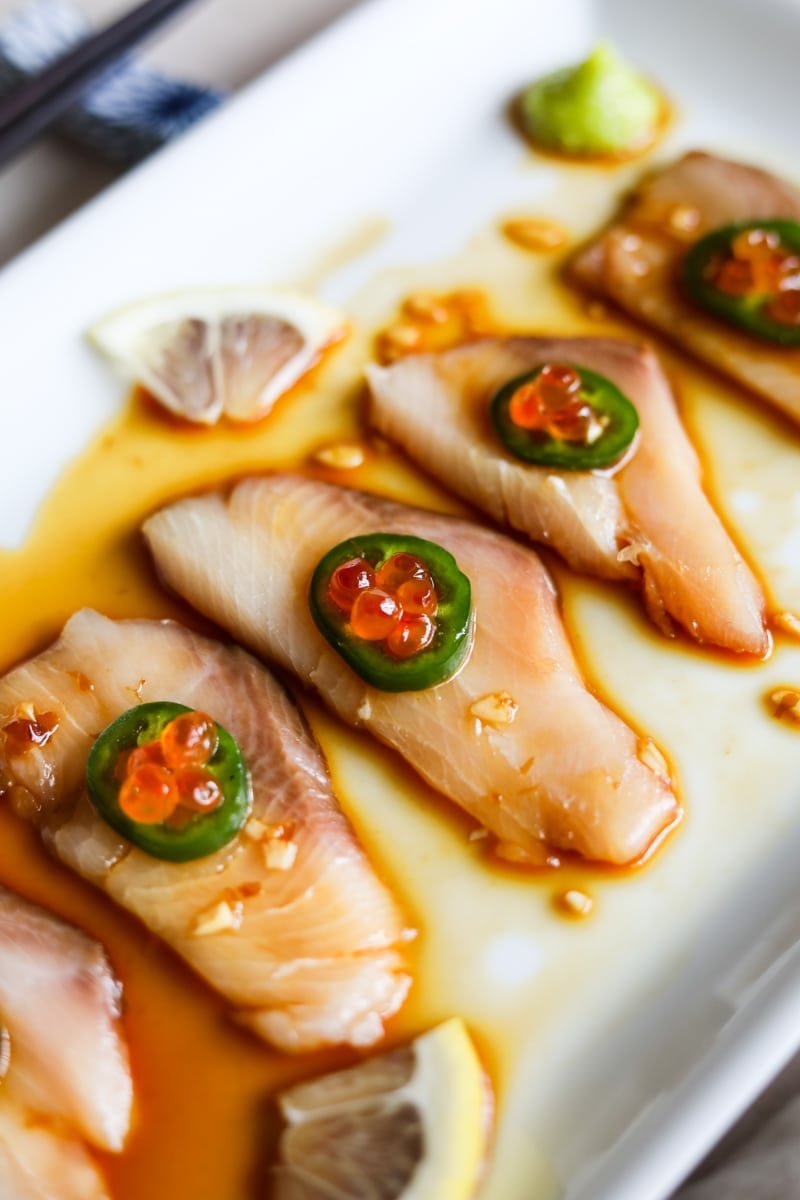
Yellowtail sashimi is delicious on its own and can be dressed up with extra umami flavor and texture, as made famous by Nobu. Top it with bright and smoky yuzu ponzu, spicy jalapeño, briny ikura, and minced garlic. Make the yuzu ponzu from scratch or use store-bought yuzu ponzu to save time. This flavorful hamachi dish will quickly become one of your favorite appetizers because it is both refreshing and light. Enjoy it with Japanese rice and wasabi for an extra pungent kick!
Jump to:
About This Dish
- Taste - The mild hamachi flavor combines with the bright citrus garnish to create a rich flavor explosion.
- Texture - The hamachi and dressing are smooth and buttery while the jalapeno adds a spicy crunch.
- Effort - All you need to do is simmer the sauce and precisely cut the fish.
- Time - It takes about 15 minutes to make the ponzu and about 10 minutes to cut and assemble the remaining ingredients.
What is Hamachi?
Hamachi is also called Japanese amberjack or yellowtail (due the yellow striped side). Hamachi live in the Pacific ocean between Japan and Hawaii and are about 10 to 20 pounds when caught. When enjoyed as sashimi, its texture is soft and fatty with a mild flavor. It is high in protein and omega-3 fatty acids.
What is Crudo?
Crudo is an Italian cooking term which literally translates to "raw". In cooking, a dish is crudo when it contains raw meat that is dressed with vinaigrette, extra virgin olive oil, citrus, or other seasonings to enhance the flavor of the meat. Crudo typically refers to fish but can also describe shellfish or beef. In our hamachi crudo recipe, we dress the hamachi with a special citrusy garlicky ponzu sauce.
Ingredients
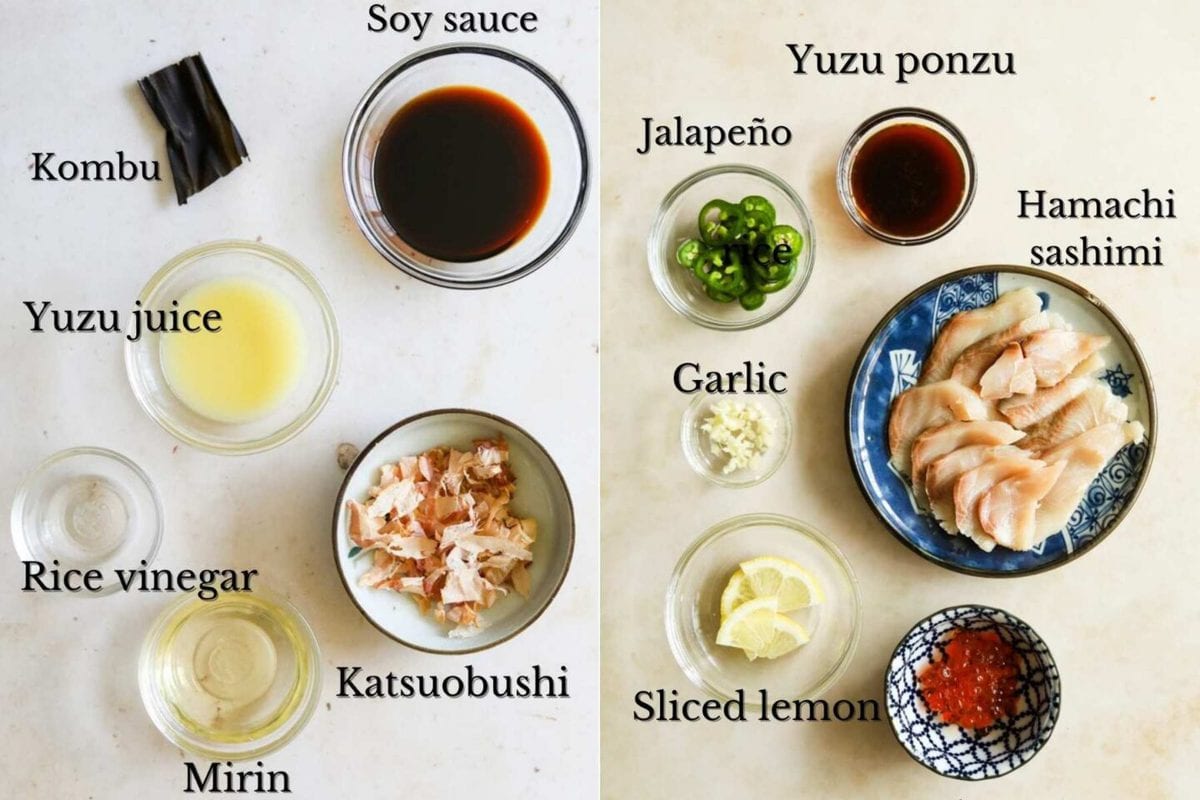
Yuzu Ponzu
- Yuzu juice - Yuzu juice adds a fresh and citrusy flavor to the sauce.
- Kombu - Kombu provides a briny sea salt flavor and is an essential ingredient to make dashi, a stock that is the foundation of most Japanese cooking.
- Katsuobushi (bonito flakes) - Katsuobushi adds a smokey flavor to the ponzu sauce.
- Mirin - Mirin is a sweet Japanese rice wine that adds to the umami flavor and is the base of many Japanese sauces and marinades.
- Rice vinegar - Rice vinegar adds a light sweet and tart flavor to the sauce.
- Soy sauce - Soy sauce, or shoyu in Japanese, is an essential condiment in Japanese cooking.
Hamachi crudo
- Yellowtail sashimi - Yellowtail (hamachi) is a buttery and fatty fish. Yellowtail's naturally mild flavor makes it perfect for dressing in ponzu sauce and other seasoning. Use sashimi grade or sushi grade hamachi for this dish since the fish is the star of the show.
- Jalapeño - Jalapeño is a bright and spicy pepper that adds a crunchy kick to the dish.
- Garlic - Thinly sliced/finely chopped or minced garlic adds the classic aroma.
- Ikura - Ikura adds a salty and briny ocean flavor.
- Lemon - Lemon brightens up the dish.
- Wasabi - Wasabi adds a pungent spice.
See recipe card for quantities.
Substitutions
- Salmon crudo - Replace hamachi with sashimi grade salmon to make salmon crudo.
- Lemon juice - You can just use more lemon juice if you don't have yuzu juice.
- Store-bought ponzu - Use store-bought yuzu ponzu or regular ponzu sauce, which you can find at your local Japanese market.
- Extra spicy - Replace jalapenos with serrano or habanero chillies if you want the dish spicier.
- Vegan - Since the ponzu sauce is rich and flavorful, this recipe will still be delicious if you make it vegan. In order to make it vegan, omit the katsuobushi and replace the hamachi with tofu then and the ikura with microgreens.
- Tobiko or masago (Japanese Flying Fish Roe) - Use tobiko instead of ikura if you want to add a slightly sweeter version of ikura.
- Lime juice - Use lime juice instead of lemon juice or yuzu juice in the ponzu sauce if you prefer the flavor of lime to lemon.
Variations
- Mild - Omit jalapeno to make this recipe mild.
- Sesame oil - Sesame oil will add a toasty flavor and nutty aroma to the sauce.
- Sugar - Add sugar to the ponzu sauce for extra sweetness.
- Green onion - Green onion will add a spicy and aromatic bite to the dish.
- Yuzu kosho - Add yuzu kosho on the side for a zesty and tart condiment.
Instructions
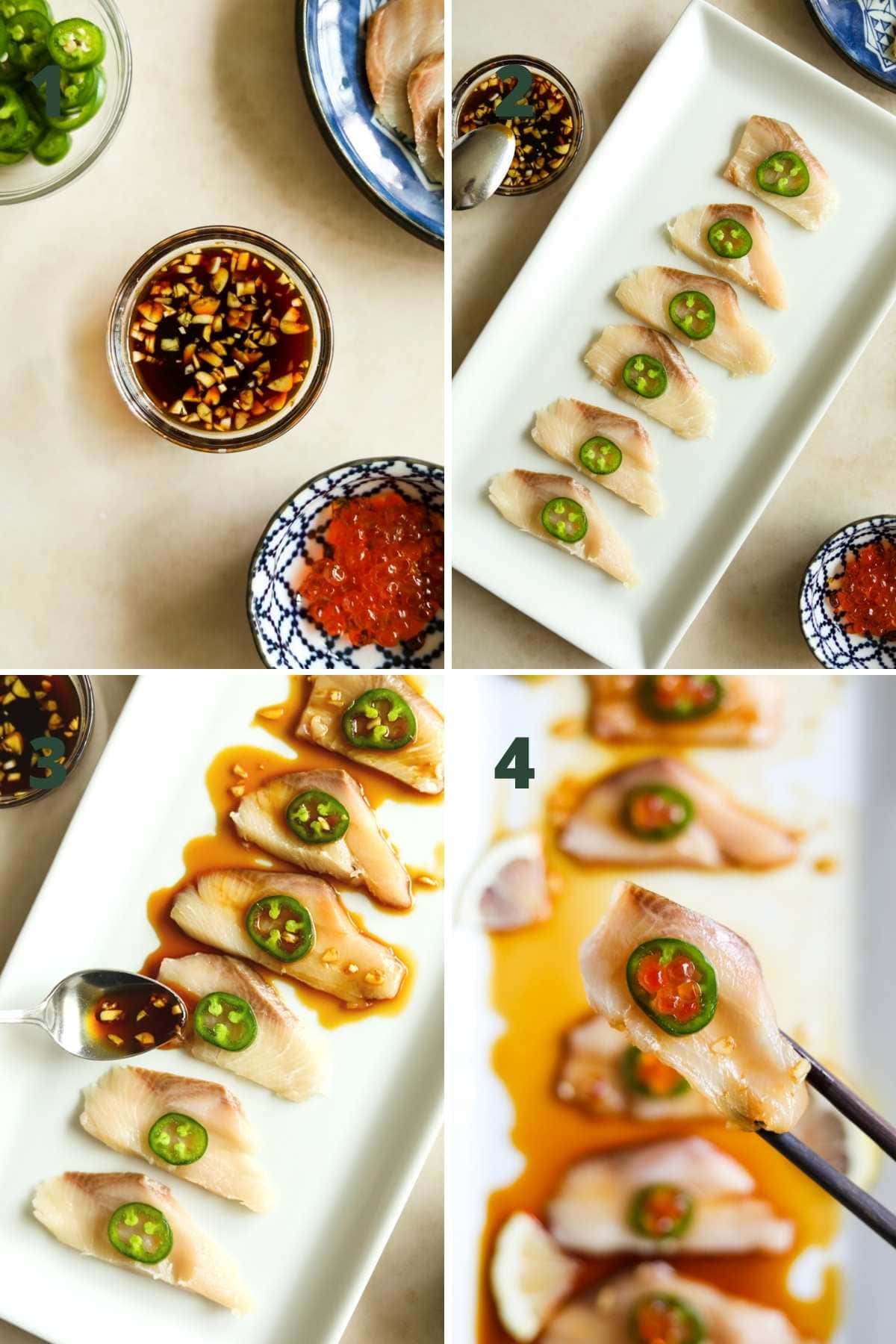
Make Yuzu Ponzu sauce
- Cook ingredients - Add kombu, katsuobushi, mirin, and rice vinegar in a small saucepan and cook on low until the mixture just simmers. Then give it a stir, remove from heat, and allow the mixture to cool. Once cooked, the mixture will smell sweet and smoky, and the Kombu will soften.
- Strain - Once the mixture cools after about 10 minutes, strain it to remove the katsuobushi and kombu and pour the mixture into a jar.
- Shake - Add the soy sauce and yuzu juice to the jar. Secure the lid on the jar and give the mixture a good shake until combined. Place in the refrigerator to chill.
Assemble dish
- Mix ponzu and garlic - Combine yuzu ponzu, soy sauce, and garlic in a small bowl and stir to combine. Let the mixture sit while you prepare the hamachi.
- Slice fish - Carefully slice hamachi against the grain at a 45° angle. Be sure to pick how large you want the slices ahead of time and cut in one smooth motion. A standard thickness is about ⅜-inch thick. Then arrange the slices on the plate and add a slice of jalapeno to each hamachi slice.
- Drizzle sauce and serve - Use a spoon to drizzle the sauce over the hamachi. Then garnish with Ikura and lemon slices and serve with wasabi on the side.
Pro tip - If you want hamachi carpaccio, cut the slices thinner, about a quarter of an inch.
How to Eat Crudo
Crudo is meant to be enjoyed as an appetizer or side on a plate or in a large bowl. Each piece of fish is meant to be eaten in one bite with dressing and jalapeno. You can also enjoy hamachi crudo with a side of rice or on top of rice. If you enjoy hamachi crudo on top of rice, be sure to let the rice cool before adding the hamachi. This will ensure that the hamachi won't cook and will maintain its buttery texture. Yellowtail crudo also goes well with these main courses:
- Alaska Sushi Roll
- Spicy Ahi Poke (Spicy Tuna Bowl)
- Shrimp Tempura Udon (Japanese noodle soup)
- Salmon Sashimi Donburi (Rice Bowl)
Recipe FAQs
The ingredients are usually available at Japanese markets, like Mitsuwa or Nijiya, or some common chain grocery stores. Sushi grade hamachi is also usually available in Japanese grocery stores, Whole Foods, or small specialty grocers. If they don't have it, you can also go to a local fish monger or seafood market. If you are based in the San Francisco Bay Area, we highly recommend Four Star Seafood, a chef-curated grocery service.
Both crudo and sashimi are raw fish. But crudo is served with a sauce or dressing while sashimi is not. Sashimi focuses only on the quality of the fish itself and how it is prepared.
Carpaccio is a type of crudo where the fish is cut into thin slices and pounded razor thin. It also usually includes the vinaigrette, citrus, and/or olive oil dressing.
Crudo means the raw fish is simply dressed in citrus and other garnishes while in ceviche, the fish is marinated in citrus juice to make it appear cooked and change its texture. Ceviche juice has eight times the amount of acid as crudo and the fish sits in the marinade for several hours prior to serving.
Yes, most of the ingredients are healthy and the dish is low in calories. If you want to make this dish even healthier, reduce the amount of ponzu sauce you use or use reduced sodium shoyu.
While this dish includes raw fish, it is safe to eat. Please keep in mind that hamachi is high in mercury so it should be eaten moderation. You also should not eat this dish if you are pregnant.
Equipment
This hamachi crudo recipe requires a few kitchen essentials. To slice the hamachi sashimi, you will need a knife and a cutting board. If you want to enjoy the sashimi with rice, you will need a pot or rice cooker to make the rice and a rice paddle to scoop the rice. For the ponzu sauce, you will also need measuring spoons, a mixing bowl, a skillet or non-stick pan, and a spoon or chopsticks to mix it.
Storage
This fresh hamachi dish is best enjoyed immediately or within 1 day of making. If you make the sauce ahead of time, be sure to store the fish and garnish/sauce in separate air-tight containers in the refrigerator so the fish stays fresh. These ingredients don't stand up well to freezing.
Top tips
- Use a sharp knife to cut the hamachi properly and ensure each individual piece comes out clean.
- In order to make cutting the fish easier, chill the fish in the fridge before you slice it. When the fish is colder, the fish is more solid and rigid so the knife slices through it easier.
- When cutting the fish, remember to always cut it against the grain and remove sinew as you go. If you cut with the grain, you can damage the fragile proteins in the fish.
- If you are preparing crudo for entertaining, you can cut the fish ahead of time, then let it chill in the refrigerator (make sure it is covered). When you are ready to serve it to your guests, all you need to do is dress it in the yuzu ponzu sauce.
- Make the yuzu ponzu a day or more ahead or use store-bought yuzu to save time when you prepare the hamachi crudo.
Related Recipes
If you want to make other delicious Japanese sides, check these out:
- Spicy Tuna Onigiri (Japanese Rice Balls)
- Miso Salmon Crudo (Carpaccio)
- Spicy Kani Roll (Crab Sushi)
- Spicy Kani Salad
- Ikura Donburi (Salmon Roe bowl)
Did You Like This Recipe?
Love this easy hamachi crudo? Please leave a 5-star rating in the recipe card below & leave a comment below. You can also try our other easy appetizers.
Sign up for THP's newsletter and keep in touch on Instagram, Facebook, Pinterest, TikTok, and YouTube. If you make this hamachi appetizer, tag #theheirloompantry so we can see your creation!
📖 Recipe
Hamachi Crudo (Yellowtail Carpaccio)
Equipment
Ingredients
Homemade Yuzu Ponzu
Hamachi Crudo
- ½ lb hamachi sliced ⅜-inch thick or less
- 1 garlic clove minced
- 2 tablespoon yuzu ponzu homemade or store-bought
- 6 jalapeno slices thinly sliced, one slice per slice of sashimi
- 1 tablespoon Ikura optional
- lemon for garnish optional
- wasabi optional
Instructions
Yuzu Ponzu
- Cook ingredients - Add kombu, katsuobushi, mirin, and rice vinegar in a small saucepan and cook on low until the mixture just simmers. Give it a stir, remove from heat, and allow the mixture to cool. The mixture will smell sweet and smoky, and the Kombu will soften.1 strip of kombu, ¼ cup katsuobushi, 1 teaspoon rice vinegar, 3 tablespoon mirin
- Strain - Once the mixture cools after about 10 minutes, strain it to remove the katsuobushi and kombu and pour the mixture into a jar.
- Shake - Add the soy sauce and yuzu juice to the jar. Secure the lid on the jar and give the mixture a good shake until combined.¼ cup soy sauce, ¼ cup yuzu juice
Assemble the Dish
- Mix ponzu and garlic - Combine yuzu ponzu, soy sauce, and garlic in a small bowl and stir to combine. Let the mixture sit while you prepare the hamachi.1 garlic clove, 2 tablespoon yuzu ponzu
- Slice fish - Slice hamachi against the grain at a 45° angle. Be sure to pick how large you want the slices ahead of time and cut in one smooth motion. A standard thickness is about ⅜-inch thick. Then arrange the slices on the plate and add a slice of jalapeno to each hamachi slice.½ lb hamachi, 6 jalapeno slices
- Drizzle sauce and serve - Use a spoon to drizzle the yuzu ponzu over the hamachi. Garnish with Ikura and lemon slices and serve with wasabi.1 garlic clove, 1 tablespoon Ikura, lemon for garnish, wasabi, 2 tablespoon yuzu ponzu
Notes
- This dish is best enjoyed immediately or within 1 day of making. Store the fish and garnish/sauce in separate air-tight containers in the refrigerator. These ingredients don't stand up well to freezing.
- Make sure you use a sharp knife to cut the hamachi properly and ensure each individual piece comes out clean.
- In order to make cutting the fish easier, chill the fish in the fridge before you slice it. When the fish is colder, the fish is more rigid so the knife slices through it easier.
- When cutting the fish, remember to always cut against the grain and remove sinew as you go. If you cut with the grain, you can damage the fragile proteins in the fish.
- If you are preparing crudo for entertaining, you can cut the fish ahead of time, then let it chill in the refrigerator (make sure it is covered). When you are ready to serve it to your guests, all you need to do is dress it in the yuzu ponzu sauce.


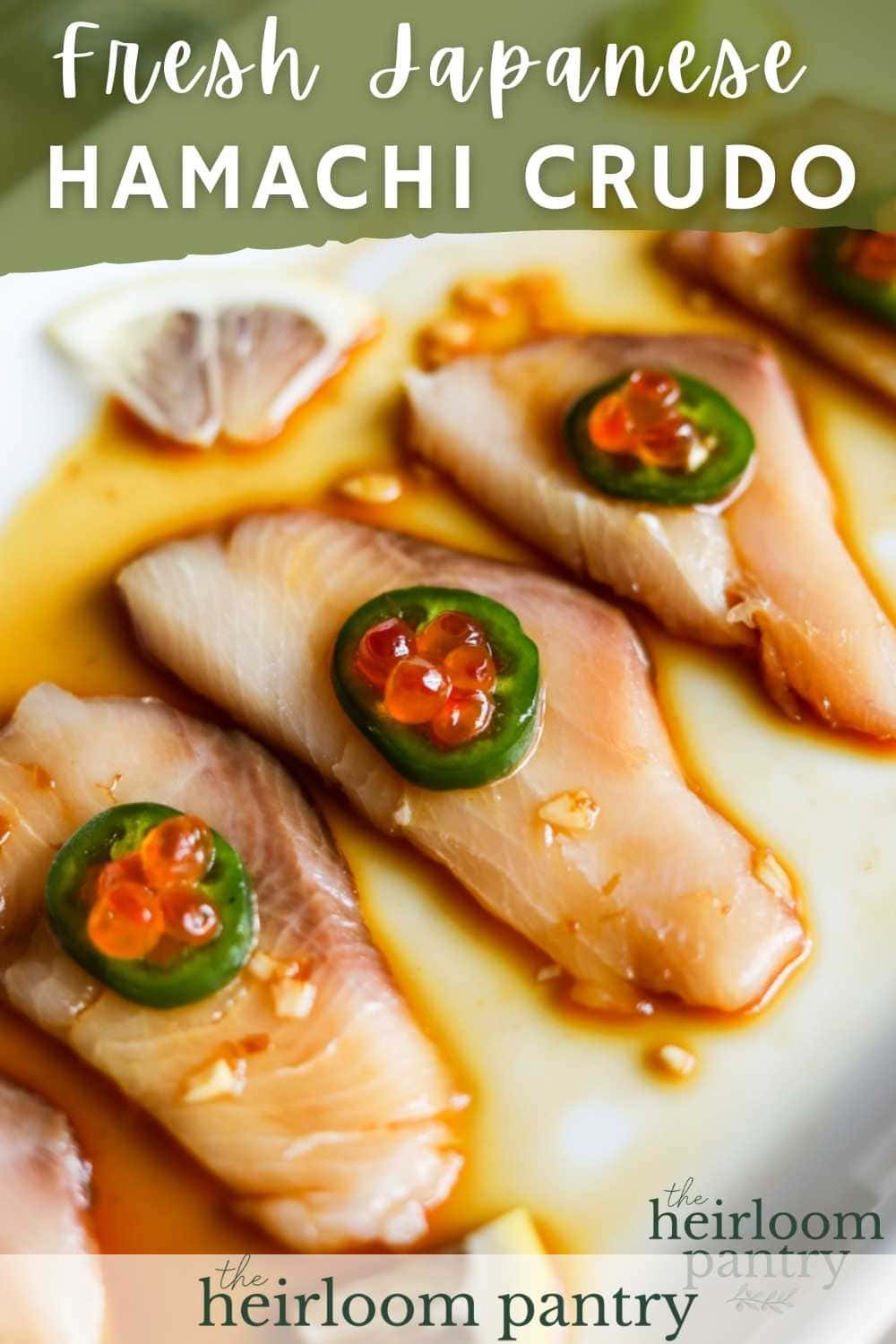


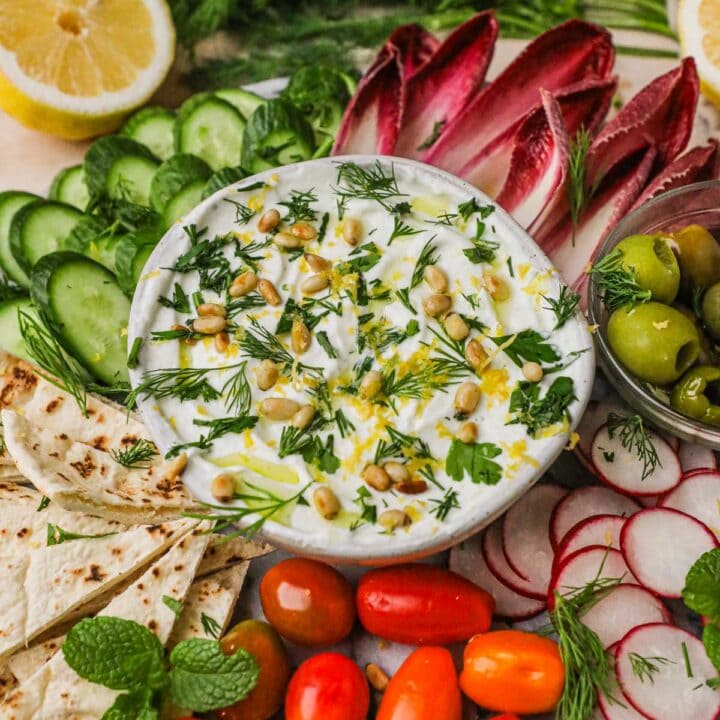

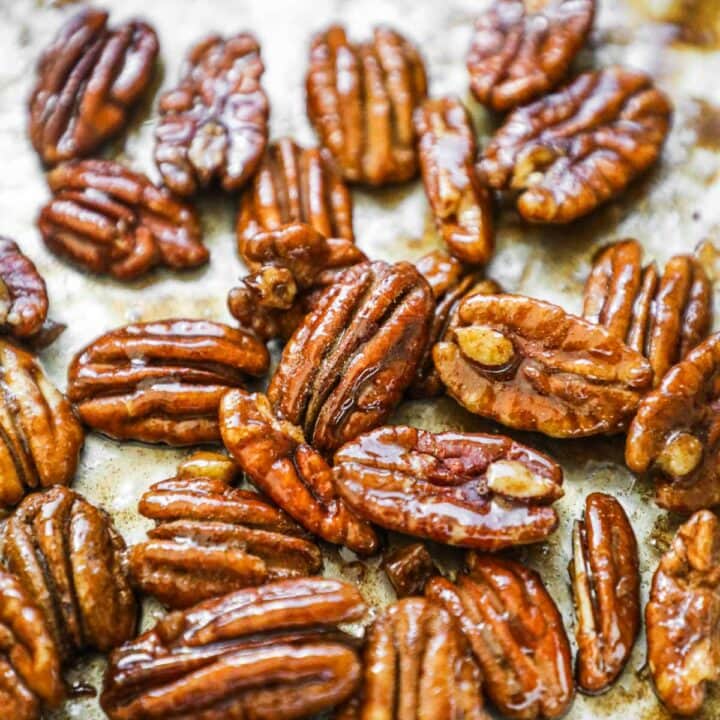

Leave a Reply